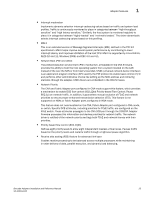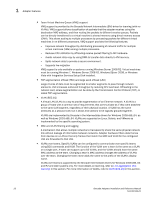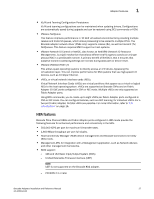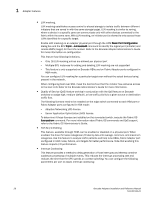Dell Brocade 1020 Brocade Adapters Installation and Reference Manual - Page 51
Internet Small Computer System Interface iSCSI over DCB., Brocade Network Intermediate Driver BNI
 |
View all Dell Brocade 1020 manuals
Add to My Manuals
Save this manual to your list of manuals |
Page 51 highlights
Adapter features 1 • Ethernet flow control Ethernet flow control is a mechanism for managing data transmission between two network nodes to prevent a fast sender from over running a slow receiver. When an overwhelmed receiver generates a PAUSE frame, this halts transmission for a specified period of time. Traffic resumes when time specified in the frame expires or PAUSE zero is received. • Flexible MAC address • Hypervisor Hypervisor is a processor-specific virtualization platform that allows multiple operating systems to share a single server platform. Refer to "Hypervisor support" on page xvii for a list of operating systems that support hypervisor operation for Brocade adapters: • Brocade Network Intermediate Driver (BNI) This provides support for multiple VLANs on ports and teams on Windows systems. This driver is installed with the adapter software. • Internet Small Computer System Interface (iSCSI) over DCB. This feature leverages pre-priority-based flow control (PFC) and enhanced transmission selection (ETS) features provided by Data Center Bridging (DCB) to Ethernet to enable more lossless delivery of iSCSI traffic in data center environments. This feature enables fabric-wide configuration of the iSCSI traffic. This is achieved by configuring the iSCSI traffic parameters on the switches, which distribute those parameters to directly-attached, DCB-capable iSCSI servers and targets. The adapter firmware obtains the iSCSI configuration from the switch through the DCB Exchange Protocol (DCBX) and applies the configuration to the network driver to classify the iSCSI traffic. The adapter will use this as a priority for all network traffic. Note the following for the different adapter models: - On CNA adapters and Fabric Adapter port configured in CNA mode, ETS support will only be supported either between network and FCoE priority or one network and iSCSI priority. - On Fabric Adapters, a separate transmit queue will be available for iSCSI traffic. This will allow iSCSI traffic to be sent on separate queue and priority and not compete with network traffic. This feature is not supported on Solaris systems. • Link aggregation (NIC teaming) A network interface "team" is a collection of physical Ethernet interfaces (CNA ports and Fabric Adapter port configured in CNA or NIC mode) acting as a single interface. Teaming overcomes problems with bandwidth limitation and redundancy often associated with Ethernet connections. Combining (aggregating) ports can increase the link speed beyond the limits of one port and provide redundancy. You can team up to eight ports across multiple CNAs (and Fabric Adapter ports configured in CNA or NIC mode) in three modes: failover, failback, or 802.3ad using BCU commands and HCM dialog boxes. - Failover mode provides fault tolerance. Only one port in a team is active at a time (primary port), and the others are in standby mode. If the primary port goes down, a secondary port is chosen using a round-robin algorithm as the next primary. This port continues to be primary, even if the original primary port returns. Brocade Adapters Installation and Reference Manual 23 53-1002144-01















